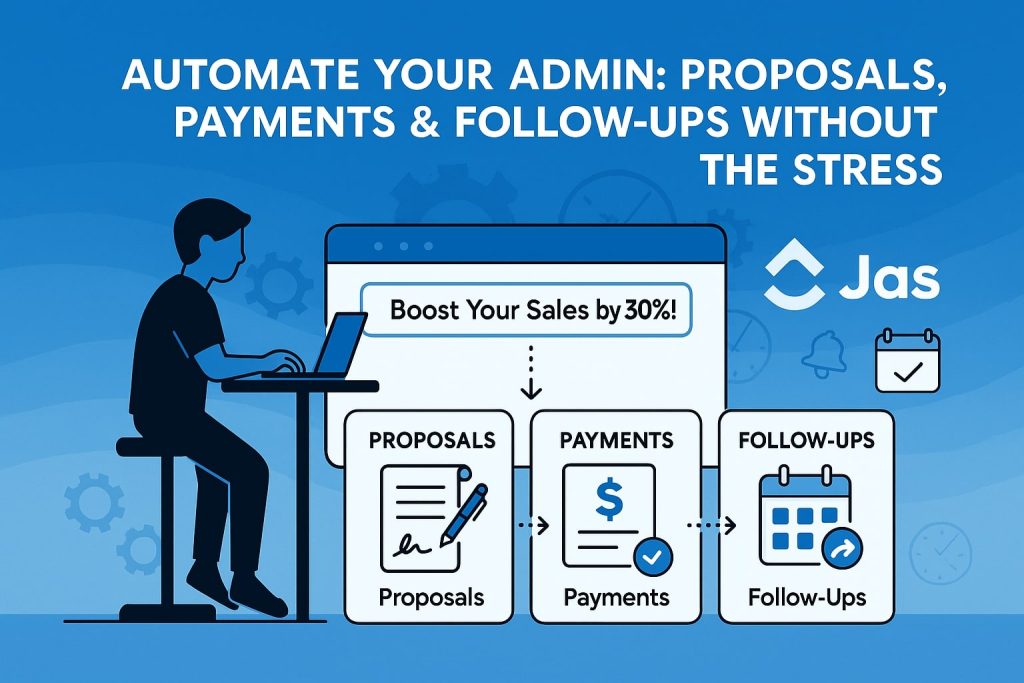You Didn’t Start Freelancing to Do Paperwork
You became a freelancer for the freedom — but most days, it doesn’t feel that way.
Instead, you’re:
-
Writing proposals
-
Chasing late invoices
-
Creating contracts
-
Sending reminders
-
Managing timelines and onboarding… manually
Every task eats 10–15 minutes. Multiply that by every client — and suddenly, your actual work gets pushed into nights and weekends.
The problem isn’t that these tasks don’t matter.
The problem is doing them all by hand, every time.
The solution? Build a simple admin stack that works while you work — powered by tools that do the repetitive, so you can focus on results.
This article shows you how to:
-
Automate contracts, proposals, and onboarding
-
Streamline invoices and get paid faster
-
Set up follow-up sequences that feel personal — even when you’re busy
By the end, you’ll have a blueprint for running your business like a business — without needing a full-time assistant.
Why Freelance Admin Becomes a Time Trap (and How to Fix It)
Ask any freelancer what eats up the most time — and it’s not the creative work.
It’s everything around the work.
You know the pattern:
-
A new client says “yes”
-
You scramble to draft a proposal
-
You Google an old contract to reuse
-
You forget to invoice until two weeks later
-
You don’t follow up until it’s awkward
It feels like a full-time admin job — and it is.
But the truth is: 90% of your admin tasks follow the same pattern.
That means they can be:
-
Templatized once
-
Automated forever
-
Customized with small tweaks when needed
The key isn’t more effort — it’s smarter systems.
With a good tool stack and 1–2 hours of setup, you can reduce your admin time by 50% or more.
In the next sections, we’ll break that down:
-
Tools for contracts and proposals
-
Systems to send and automate payments
-
Follow-up workflows that protect your income and reputation
Let’s start at the beginning: client onboarding.
Automate Proposals & Contracts in 10 Minutes or Less
When a new client is ready to start, speed builds trust.
But most freelancers delay the process because they need to manually:
-
Write a proposal
-
Customize a contract
-
Send it for signing
-
Confirm everything by email
That lag can make a hot lead go cold.
Here’s how to fix it with a system that takes less than 10 minutes to run — and only needs to be built once.
Step 1: Create Reusable Proposal Templates
Use a tool like Notion, Google Docs, or Bonsai to create a clean, professional proposal template.
Structure it like this:
-
Project Summary
-
Timeline
-
Deliverables
-
Pricing & Payment Terms
-
Optional Add-ons
-
Signature or Acceptance Area
You can include toggles for sections you can quickly remove or duplicate based on the project size.
Once built, this becomes your base for every project — just duplicate and tweak.
Step 2: Build a Smart Contract Template
Instead of starting from scratch each time, create a customizable contract that includes:
-
Scope of work
-
Timeline and deliverables
-
Payment terms
-
Late fee clause
-
Revision policy
-
Termination clause
-
Signature fields
Use tools like Bonsai, Fiverr Workspace, or PandaDoc to insert client data automatically and send it for e-signature in seconds.
Step 3: Connect Proposals to Contracts in One Flow
If possible, use one tool (e.g., Bonsai) to link proposal → contract → invoice.
Once the client approves the proposal, the contract is auto-filled and ready to sign.
This reduces back-and-forth and helps you onboard clients in under 24 hours — while looking highly professional.
Invoicing & Payments That Run Themselves — and Get You Paid Faster
The hardest part about getting paid… is asking to be paid.
Freelancers often delay sending invoices — or forget altogether — because:
-
It feels awkward
-
There’s no system
-
It’s yet another thing to manage
But without consistent invoicing, you:
-
Create unpredictable cash flow
-
Spend emotional energy chasing payments
-
Undervalue your own work
Here’s how to flip the script and let your system do the asking for you — so you can focus on delivering, not reminding.
Step 1: Set Up Smart, Branded Invoices
Tools like Fiskl, Bonsai, or PayPal Invoicing let you:
-
Create branded invoice templates
-
Save client info and payment terms
-
Auto-fill recurring services or rates
-
Add payment options (bank, Stripe, PayPal)
Include:
-
Clear due dates
-
Service breakdowns
-
Notes about late fees (if any)
-
Payment link (clickable + friction-free).
Step 2: Automate Invoice Delivery
For projects with fixed milestones or monthly billing:
-
Schedule invoices in advance
-
Sync them to project completion stages
-
Set automatic reminders at 3, 7, or 14 days overdue
Clients receive invoices on time without you lifting a finger, and you stay consistent — which makes you look more professional.
Step 3: Track Payments in One Dashboard
Freelancers often don’t know:
-
What’s overdue
-
What’s pending
-
What’s actually been paid
With the right setup, your invoicing tool can show:
-
Total income this month
-
Unpaid invoices
-
Average payment time by client
-
Who to follow up with — and when
This gives you peace of mind and a better grasp on your business metrics.
Follow-Up Sequences That Feel Personal (Even When You’re Busy)
You delivered great work. The client was happy.
Then… silence.
They forget to reply. You forget to follow up.
And that next project — or referral — never happens.
Most freelancers lose potential income not from bad delivery, but from not staying visible.
But follow-ups don’t have to feel awkward or robotic.
With the right tools, you can stay top of mind — consistently and professionally — even when you’re too busy to write a single email.
Step 1: Set Follow-Up Triggers Based on Project Milestones
Use tools like Harlow, Flowrite, or a basic CRM like Notion or Trello with email automation.
You can create sequences that trigger when:
-
A contract ends
-
An invoice is paid
-
A project is delivered
-
A client goes inactive for 30+ days
Each one can launch a personalized message, such as:
“Hey [Name], just checking in — how’s [Project Name] performing? Let me know if you’d like to build on it.”
Step 2: Use Pre-Written Sequences (but Customize the First Line)
The secret to automated follow-ups that feel human?
The first sentence.
Make sure it refers to:
-
A specific project
-
A shared experience
-
A goal the client mentioned
After that, the rest of the message can be from your saved library — clear, warm, and respectful of their time.
Step 3: Track Responses and Plan Re-Engagement
Make sure your system logs:
-
Who replied
-
Who clicked
-
Who went silent
That way, you can:
-
Reconnect with warm leads after 3–6 months
-
Invite happy clients to leave a testimonial
-
Offer retainers or new services at the right time
Following up isn’t pushy — it’s professional.
And with the right flow, it doesn’t take time or energy. It just… works.
A Weekly Workflow That Runs Your Admin for You
Now that you’ve seen how to automate proposals, contracts, invoicing, and follow-ups — let’s tie it together.
You don’t need a big team.
You just need a repeatable weekly system that runs in the background while you work on what actually matters.
Here’s a sample workflow used by many top freelancers:
🗓 Monday – Admin Setup in 20 Minutes
-
Review upcoming proposals
-
Duplicate and send templated contracts
-
Schedule any known invoices
-
Review past week’s follow-ups
Tool Stack: Notion + Bonsai + Fiskl
📅 Wednesday – Midweek Pulse Check (10 Minutes)
-
Review dashboard: what’s been signed, paid, or ignored
-
Manually personalize a key follow-up or testimonial request
-
Check overdue invoices — auto-reminders should be running
Tool Stack: Your invoice platform + CRM dashboard
🧠 Friday – Prep Next Week’s Admin in Advance
-
Draft 1–2 client proposals using templates
-
Build pre-dated invoices for recurring clients
-
Review automation logs (what worked / failed)
-
Clean up client notes or follow-up tasks
This rhythm takes less than 1 hour/week, and replaces dozens of small, scattered tasks that kill your focus.
Conclusion: Work Smart, Not Just Hard
Freelancing shouldn’t mean doing everything by hand.
When you automate the admin side of your business:
-
You close deals faster
-
You look more professional
-
You get paid on time
-
And you never forget to follow up again
You don’t need to be a robot — your systems can handle that for you.
Set it up once. Let it run.
Then reclaim your evenings, weekends, and creative energy.



